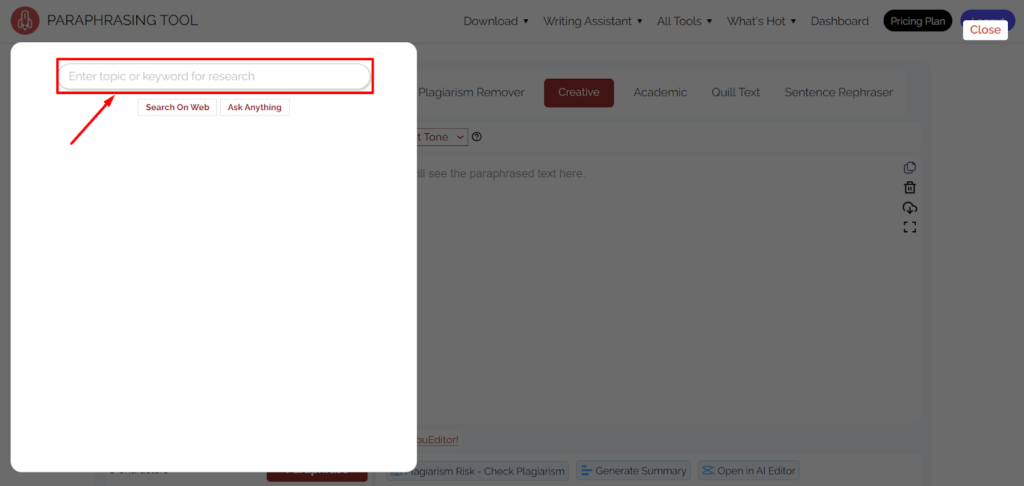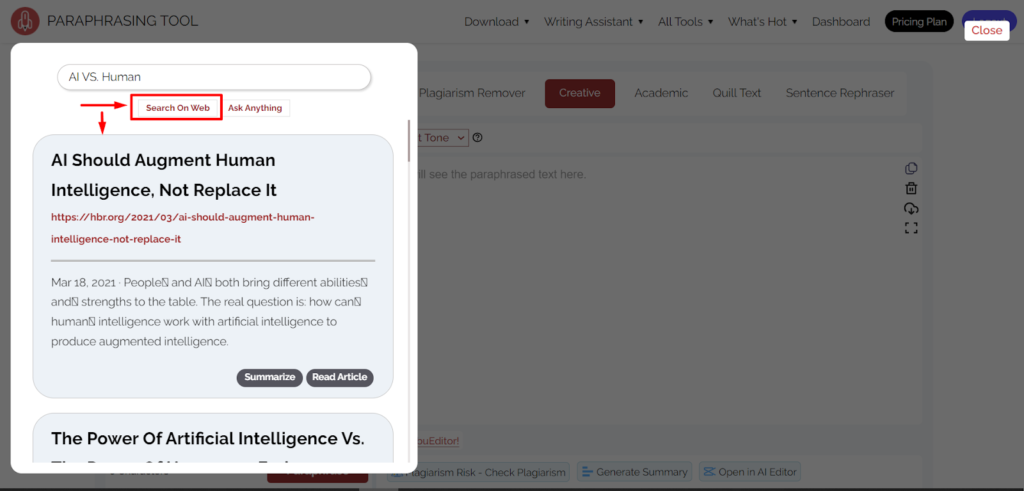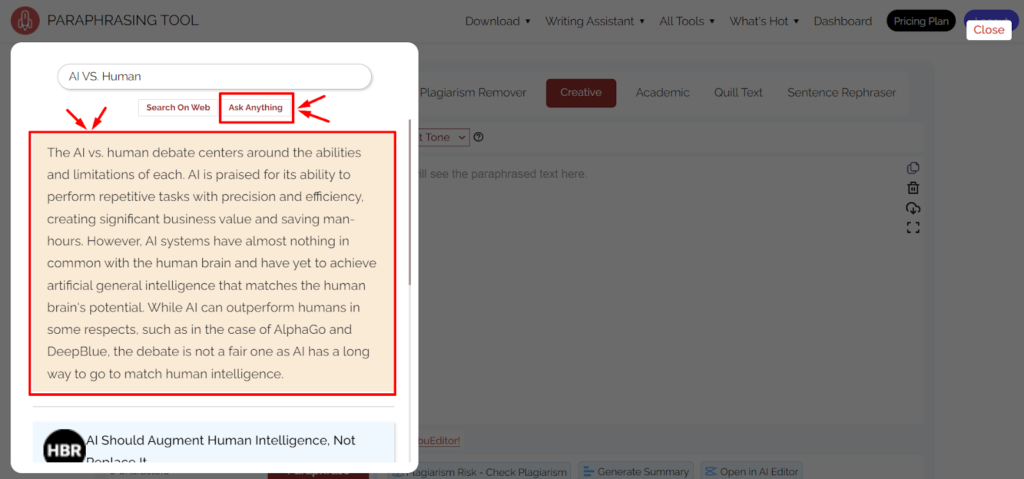
It is not wrong to say that research papers have always been the main way to create and share knowledge.
One of the key skills that researchers need to develop is paraphrasing, which involves rewording existing text to express the same idea in a different way. In fact, paraphrasing has revolutionized how research papers are written and perceived.
Rather than simply replicating existing content, scholars are able to engage more deeply with their sources, interpret them in their own words, and henceforth, enhance the originality of their papers.
This not only enables the assimilation of diverse perspectives, but also promotes a thorough understanding of the topic at hand. So, let’s get started.
- Do Your Research
Before even commencing with paraphrasing, it is essential to conduct a comprehensive research. This means, seeking out reliable sources that provide a holistic view of the topic you’re researching on.
- Identify Relevant Information: Not all information will be pertinent to your research. So, understand your research question and identify sources that provide relevant data, theories, and viewpoints.
- Critical Reading: When reading through your sources, be critical and interpret the text in light of your research question. This will make it easier to understand the content and later paraphrase it effectively.
- Note-taking: Make notes of the main ideas, supporting arguments, and data from each source. This will ensure that you don’t miss out on crucial points when you start writing your research paper.
Manual research can be problematic or sometimes, you don’t get what you wanted, then what to do?
Paraphrasingtool.ai can be a good option in this context as it has its own integration with a research panel. What does it mean?
By using this tool, you don’t need to use any third party search engine, all you need is to follow the steps mentioned below:
- Click on the “Research” button.

- Enter the topic or keyword to search.

- Click on the “Search on Web” button to get the relevant articles.

- Or click on the “Ask Anything” button to get the to-the-point and the most-relevant answer.

- Divide the Kind of Sources
To have a rich and comprehensive research paper, it’s essential to diversify your sources. This provides a balanced view of your topic. The type of sources can typically be divided into three categories:
- Primary Sources: These are first-hand sources that provide direct evidence about the topic you’re studying. Examples include interviews, surveys, or historical documents.
- Secondary Sources: These are interpretations or analysis based on primary sources. Examples include books, articles, and reviews. They provide a good starting point as they compile and interpret primary sources.
- Tertiary Sources: These include resources that compile or index primary and secondary sources. Examples are encyclopedias, bibliographies, or databases. They provide a broad overview and can help identify relevant primary and secondary sources.
By understanding the type of source, you can determine how to best paraphrase the information it provides.
- Start Paraphrasing
Once you’ve conducted thorough research and divided your sources, it’s time to begin the paraphrasing process.
But first of all, decide whether you go for the manual paraphrasing or you are going to use the paraphrasing tool.
- Manual Paraphrasing
This involves reading the source text, comprehending it, and then rewording it in your own style while maintaining the original meaning.
Manual paraphrasing is a skill that improves over time and practice. It encourages critical thinking and deeper understanding of the content.
Here’s an example:
Original: “Climate change is an urgent problem that requires immediate action.”
Paraphrased: “Immediate measures are required to address the pressing issue of climate change.”
Advantages of Manual Paraphrasing:
- Better Understanding: Manual paraphrasing encourages you to read and understand the material in-depth, which can increase your grasp of the subject matter.
- Customized Style: You can tailor the style and tone of your writing to fit the overall narrative of your research paper.
Disadvantages of Manual Paraphrasing:
- Time-Consuming: It can be quite time-consuming, especially for lengthy documents or complex subjects.
- Risk of Unintentional Plagiarism: If not done carefully, manual paraphrasing can result in text that is too close to the original, leading to unintentional plagiarism.
- Using a Paraphraser
The paraphrasing tool can be used to reword the source text in no time. This tool is particularly useful when you’re dealing with large volumes of text.
However, while they can help in terms of time-efficiency, they always preserve the original meaning accurately. But always cross-check the output of these tools for accuracy and coherence.
Original: “Technological advancements are rapidly transforming the healthcare sector.”
Paraphrased (by AI Paraphrasing Tool): “The healthcare industry is rapidly changing due to technological advancements.”

Advantages of Using the AI Paraphrasing Tool:
- Efficiency: These tools can paraphrase large amounts of text quickly, making them useful for handling large documents or multiple sources.
- Consistency: Automated tools can maintain consistency in rewording, especially for repetitive texts.
Disadvantages of Using a Paraphraser:
- Lack of Context: Automated paraphrasers might not fully understand the context or nuances of the text, leading to inaccuracies in the paraphrased text.
- Need for Review: The output often needs to be reviewed and potentially corrected by a human to ensure it retains the correct meaning and coherence.
- Cite the Sources
Even when you paraphrase, it’s important to attribute the ideas to the original source. This is done through citation. Citation not only prevents plagiarism but also lends credibility to your research paper.
It allows readers to locate your sources and delve deeper into the topic if they wish to. There are several citation styles, and the one you should use depends on your field of study or the requirements of your institution.
Here are some of the common ones:
- APA (American Psychological Association): Widely used in social sciences. It follows an author-date citation system. For example: (Smith, 2020).
- MLA (Modern Language Association): Common in humanities. MLA style includes the author’s name and page number in parentheses. For example: (Smith 12).
- Chicago: Utilized in various disciplines. It provides two styles: author-date and notes-bibliography. For example: (Smith 2020, 12) or a footnote at the bottom of the page.
- Harvard: Predominantly used in the UK and Australia, this author-date style is similar to APA. For example: (Smith, 2020).
Regardless of the citation style used, a complete reference should also be included in a bibliography or reference list at the end of the research paper.
- Proofread the Paraphrased Text
After paraphrasing and citing your sources, it’s imperative to proofread the paraphrased text. This ensures the preservation of the original ideas, checks for proper citation, and rectifies any grammatical or punctuation errors.
- Check for Accuracy: Make sure that the paraphrased text accurately represents the original source’s ideas and context.
- Cross-Check Citations: Ensure that every paraphrased section is properly cited and matches the source in your reference list.
- Correct Language Errors: Watch out for any spelling, punctuation, or grammar mistakes and correct them. You can take help from the grammar checker available online.

By meticulously proofreading, you enhance the readability of your research paper and assure the quality and integrity of your work.
Conclusion
Paraphrasing is transforming the approach to writing research papers. By enabling the assimilation of diverse perspectives, it promotes a comprehensive understanding of the topic at hand.
The process involves conducting thorough research, understanding the different sources, paraphrasing—either manually or using a tool, citing the sources appropriately, and finally proofreading the paraphrased text.
Each step is equally important and contributes to producing a research paper that is original, informative, and credible. Thus, mastering the art of paraphrasing can significantly elevate the quality of your academic writing.

He is an SEO wizard and founder of Top Study World & Nafran, has been featured more times than a celebrity on Ahrefs, Semrush, Dawn News, Propakistani and dozens more. His superpower? Helping students ace their exams!


![How to Memorize Mathematical Theorems [3 Effective Ways]](https://www.topstudyworld.com/wp-content/uploads/2017/11/How-to-Memorize-Mathematical-Theorems-Easily-3-Effective-Ways.png)